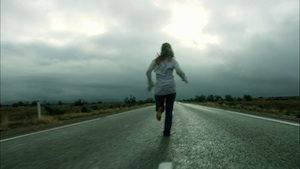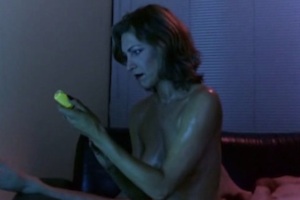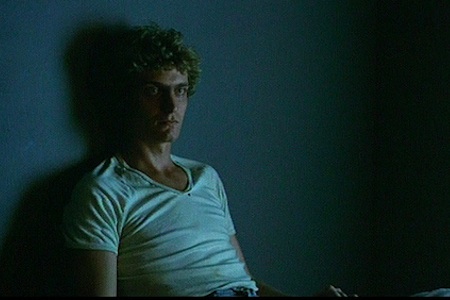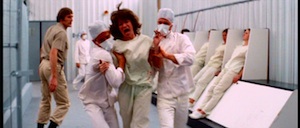News recently hit the pipeline that Mark Hartley and Justin King—makers of the marvelous 2008 documentary Not Quite Hollywood: The Wild, Untold Story of Ozploitation!—were embarking on their first narrative feature. Fittingly enough, it’s Patrick, a projected remake of the 1978 Aussie horror film that was itself quite possibly the most internationally successful product of the Australian exploitation-flick “golden age” chronicled in their documentary.
Patrick is decidedly peculiar for a horror film, or any other kind of film for that matter. Its title figure is a young man who lies comatose—but his eyes eerily wide open—in a hospital bed after murdering his slutty mother and her latest boyfriend (or trick). Through the entire bulk of the film he doesn’t move a muscle, or say a word.
Nonetheless, Patrick is somehow aware of his surroundings—and that Nurse Kathy (Susan Penhaligon) is the only clinic staffperson who sees him as more than a bag of living meat suitable for Dr. Roget’s rather sinister experiments with consciousness. She talks to him, never mind that he gives no sign of understanding; perhaps she needs a confidante, as she’s currently going through troubles, separating from a husband (Rod Mullinar) who won’t leave her alone. Mentally disturbed in his vegetative state as he apparently was while awake, Patrick repays her kindness in his very own special way: By psychically terrorizing her perceived enemies, his own, and finally Kathy herself.
Patrick wasn’t entirely unusual for 1978, as the movies were in the midst of a brief craze for telekinesis. It started with Carrie in 1976 and soon encompassed The Fury, Scanners, Firestarter, and more. But Patrick’s immobile antihero with the ability to kill via simple will—played by creepily gaunt, pop-eyed Robert Thompson—was a real novelty that tweaked moviegoers’ fancy. It was a great financial if not much of critical success worldwide, doing so well in Italy that producers there soon cranked out an unauthorized sequel (1980’s Patrick Still Lives). While never again so blatantly imitated, the original nonetheless helped set a template for Ozzie horror that was technically slick but conceptually just a little…off.
No complaints about that here, though. With plenty of routine, by-numbers horror entries clogging drive-ins and grindhouses back then, cable slots and Netflix queues today, any dose of eccentricity in the genre is welcome. And on that count, Australia has consistently delivered. Not all its efforts in that department have been memorable, or even good. But fortunately even the least of them often have some over-the-top conceptual or stylistic elements that compel more interest than your average umpteenth slasher knockout could ever hope to. Four in the current Fandor collection—including Richard Franklin’sPatrick—together provide a particularly good introduction to the idiosyncrasies of cinematic horror Down Under.
Getting a very late start in the genre—at the time local filmmakers in the midst of their first exploitation wave were much more drawn toward cheesy sex comedies like The Naked Bunyip and Barry McKenzie Holds His Own—Australia didn’t have its first proper horror film until 1972. Just 54 minutes long, Terry Bourke’s Night of Fear was intended for television but deemed far too scary and graphic for broadcast. Its dialogue-free tale of a young woman’s kidnapping and torture at the hands of a rural inbred was initially banned by censors from playing theaters, where it died a quick death after finally being released.
At least the continent was no longer virgin horror territory. After Night and before Patrick, there was only one more outright horror film (Bourke’s own satisfyingly bizarre Inn of the Damned), but several others that flirted with horror material, most notably the illustrious Peter Weir’s early features (especially apocalyptic The Last Wave). Patrick seemed to trigger something, however. The next year saw two notable, genre-stretching and defiantly odd horror exercises.
‘Long Weekend’ went so far out on a limb—straddling the “nature’s revenge” theme of so many 1970s ‘eco-horror’ films with the extreme stylistic and narrative ambiguity of an arthouse head-scratcher like Peter Weir’s ‘Picnic at Hanging Rock’—that genre fans had no idea what to make of it. But amongst more adventurous viewers, the original is now regarded as a one-of-a-kind cult classic.
Thirst, a first theatrical feature by Rod Hardy (who’s almost exclusively worked since in TV, including episodes of The X-Files and Burn Notice), was a vampire movie that resembled others of that type to date far less than it did another 1979 release, The Clonus Horror. (That obscure American feature later gained some infamy when it turned out that the scenarist of Michael Bay’s hugely expensive 2005 sci-fi thriller The Island had borrowed a few too many story details, resulting in legal action.) Both take place at an isolated location where humans are professionally “bred” for diabolical purposes: As unwilling organ donors or, in Thirst, “blood cows” for “The Brotherhood,” an underground global network of blood-drinkers.
Abducted and taken here, heroine Kate (Chantal Cantouri) is not amused to discover she’s the descendant of infamous medieval mass murderess Countess Elizabeth Bathory, and horrified by the program of “transition” she’s put through to join this “superior race” as a sort of Queen by inheritance. Her travails increasingly blur the line between reality and drugged delusion until neither she nor we can quite tell which is which. The producers banked on making this bizarre story a little more familiar by casting well-known (if past-prime) international actors David Hemmings and Henry Silva in supporting roles—as well as Robert Thompson and Rod Mullinar, back from the dead after Patrick.
However much it digressed from subgenre norm, the word “vampire” alone made Thirst clear-cut horror material. Colin Eggleston’s Long Weekend, however, went so far out on a limb—straddling the “nature’s revenge” theme of so many 1970s “eco-horror” films with the extreme stylistic and narrative ambiguity of an arthouse head-scratcher like Peter Weir’s Picnic at Hanging Rock—that genre fans had no idea what to make of it. Some of them still don’t (nor did a poorly received recent remake with Jim Caviezel help matters), but amongst more adventurous viewers, the original Weekend is now regarded as a one-of-a-kind cult classic.

Melbourne proto-yuppies Peter (John Hargreaves) and Marcia (Biony Behets) are off to the country for the weekend—he obeying some sort of macho-blowhard call toward the sporting life, she kicking and screaming at the sacrifice of “roughing it” when they might have spent the time at a nice hotel with a pool and cocktail lounge. Yet they’ve practically dragged half of civilization’s accoutrements with them, with which they proceed to despoil nature once they’ve landed in its midst. Littering, polluting, flattening, shooting, denuding, they do everything imaginable to ruin the natural environment they’re “enjoying,” all the while bickering non-stop. Mother Nature, first planting a few discreet hints that such behavior is unwelcome here, eventually settles down to the business of shutting these intruders up. For good.
It takes a while to grok just what Eggleston is up to here: That our protagonists really are meant to be as obnoxious as they are, as microcosmic stand-ins for an entire species that’s forgotten to respect the eco-system of which it is but one destructive, dispensable part. Still, Long Weekend plays it cagey throughout. There’s no radioactive-mutant “monster” in the shadows, no supernatural or pseudo-scientific explanation for what happens to Peter and Marcia. We can never be sure the events that befall them aren’t just a series of bizarre, ill-luck coincidences—including the slam-dunk of a final “accident” that ends matters with a giddily grotesque exclamation point.
Patrick wasn’t entirely unusual for 1978, as the movies were in the midst of a brief craze for telekinesis. It started with ‘Carrie’ in 1976 and soon encompassed ‘The Fury,’ ‘Scanners,’ ‘Firestarter,’ and more. But ‘Patrick’s’ immobile antihero with the ability to kill via simple will—played by creepily gaunt, pop-eyed Robert Thompson—was a real novelty that tweaked moviegoers’ fancy.
Neither of these 1979 releases were particularly successful at the box-office, but they heralded a relative glut of horror and quasi-horror thrillers—many aimed hopefully at international audiences with imported stars like Halloween’s Jamie Lee Curtis—that lasted through the entire VCR age. Among the most interesting, and not by coincidence most essentially Australian, were Russell Mulcahey’s grotesque outback gorefest Razorback, John Hillcoat’s futuristic prison nightmare Ghosts of the Civil Dead, Brian Trenchard-Smith’s Clockwork Orange-goes-slumming Dead End Drive In (from a story by leading Oz novelist Peter Carey), and Rolf de Heer’s sci-fi mystery Incident at Raven’s Gate.
Craziest and most overtly black-comedic of them all was a fourth title you can happily access streaming here. Aussie musician, writer, visual artist and (too infrequently) filmmaker Philip Brophy made his feature debut with Body Melt, a 1993 horror/sci-fi/satirical hybrid that doubtless flummoxed the commercial marketplace at the time and remains sadly underseen. It’s like one of David Cronenberg’s early “body horror” features (Rabid, They Came From Within, etc.) crossed with a better-crafted Troma movie boasting some actual brains behind its bad-taste splatter yuks.

A spoof of unhealthy health crazes (for starters), the movie centers on a fitness corporation whose steroid-like additives cause muscle growth, but also eventually hallucinations, mutation, and (literal) physical meltdown. The disgusting, gooey end result is but one of myriad bodily fluids on ample display here. Most of the action is confined to the company HQ and generic ‘burb Homeville, whose population is unknowingly being used as a giant lab experiment for the drugs. But we also get the misadventures of two unlucky spunk-filled teenage boys whose trip to the country hits a permanent rest stop once they run into inbred locals evoking The Texas Chainsaw Massacre as much as they do Welcome to Woop Woop.
Horror and horror-related films continue to issue from Australia, their above-average interest compensating for their relative infrequency. Greg McLean’s Wolf Creek (2005) was quite possibly the best horror of its decade from anywhere, a vividly unpleasant nightmare that took the time to make its young tourist protagonists worth caring about before their worst-case-scenario fates kicked in. It was the most alarming expression of a national cinematic staple, fear of the Outback as a malevolent force in itself.
More in the grotesquely humorous vein of Body Melt were Sean Byrne’s 2009 date-from-hell ordeal The Loved Ones and Joseph Stephen Sims’ 2010 Grand-Guignol ensemble piece Bad Behaviour, two striking first features that at this writing still haven’t found any means of U.S. distribution. Even if that doesn’t change, we’ll surely hear from their makers again—one thing history has proven over the last four decades is that talented Australian directors who first make their name in the horror genre almost invariably get pushed up th





